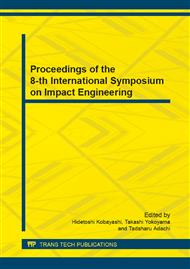p.403
p.409
p.415
p.420
p.426
p.431
p.437
p.443
p.449
Dynamic Impact Behavior of Ti-Ni Shape Memory Alloys in Two Different Compositions
Abstract:
Stress vs. strain curves of two kinds of Ti–Ni shape memory alloys under dynamic compressive loading condition were obtained by the split Hopkinson pressure bar experiment. One is Ni-rich, 50.75Ni–49.25Ti (at%) alloy and the other is Ti-rich, 49.5Ni–50.5Ti (at%). The former exists as austenite phase to show superelastic behavior at the room temperature, and the latter is martensitic phase at the room temperature. The dynamic stress–strain curves were compared with quasi-static compressive test results. The Ni-rich specimen displayed a much higher stress level at the high strain rate than at the quasi-static test, but the Ti-rich specimen exhibited a similar stress level in the two types of tests.
Info:
Periodical:
Pages:
426-428
Citation:
Online since:
June 2014
Authors:
Price:
Сopyright:
© 2014 Trans Tech Publications Ltd. All Rights Reserved
Share:
Citation:


